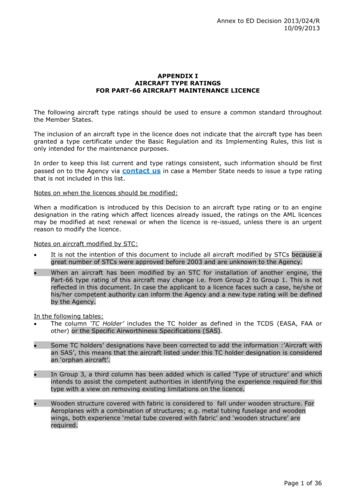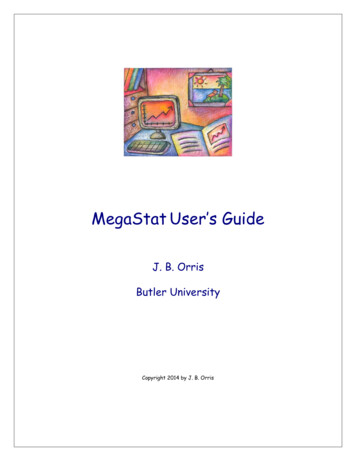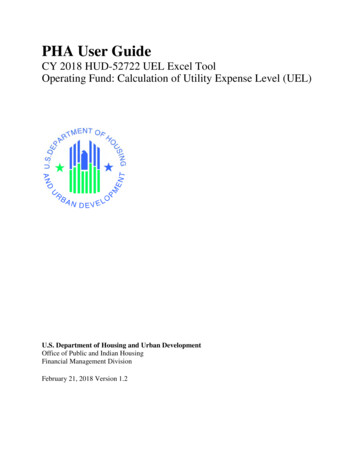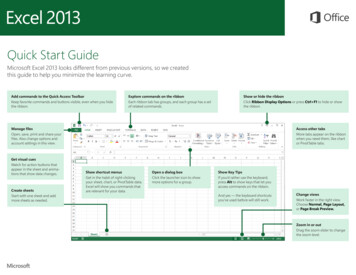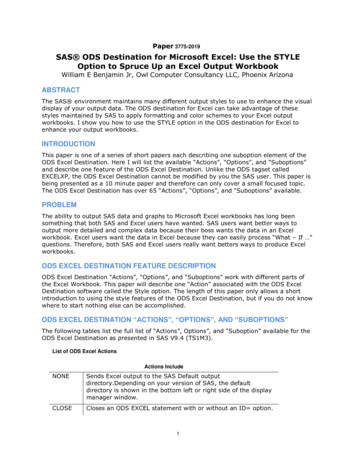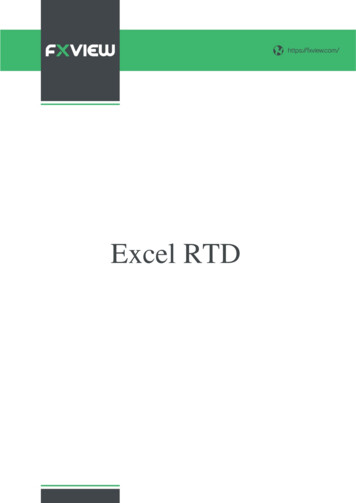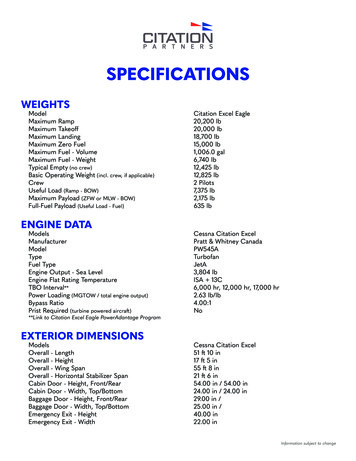
Transcription
SPECIFICATIONSWEIGHTSModelMaximum RampMaximum TakeoffMaximum LandingMaximum Zero FuelMaximum Fuel - VolumeMaximum Fuel - WeightTypical Empty (no crew)Basic Operating Weight (incl. crew, if applicable)CrewUseful Load (Ramp - BOW)Maximum Payload (ZFW or MLW - BOW)Full-Fuel Payload (Useful Load - Fuel)ENGINE DATAModelsManufacturerModelTypeFuel TypeEngine Output - Sea LevelEngine Flat Rating TemperatureTBO Interval**Power Loading (MGTOW / total engine output)Bypass RatioPrist Required (turbine powered aircraft)**Link to Citation Excel Eagle PowerAdantage ProgramEXTERIOR DIMENSIONSModelsOverall - LengthOverall - HeightOverall - Wing SpanOverall - Horizontal Stabilizer SpanCabin Door - Height, Front/RearCabin Door - Width, Top/BottomBaggage Door - Height, Front/RearBaggage Door - Width, Top/BottomEmergency Exit - HeightEmergency Exit - WidthCitation Excel Eagle20,200 lb20,000 lb18,700 lb15,000 lb1,006.0 gal6,740 lb12,425 lb12,825 lb2 Pilots7,375 lb2,175 lb635 lbCessna Citation ExcelPratt & Whitney CanadaPW545ATurbofanJetA3,804 lbISA 13C6,000 hr, 12,000 hr, 17,000 hr2.63 lb/lb4.00:1NoCessna Citation Excel51 ft 10 in17 ft 5 in55 ft 8 in21 ft 6 in54.00 in / 54.00 in24.00 in / 24.00 in29.00 in /25.00 in /40.00 in22.00 inInformation subject to change
CABIN AND BAGGAGEModelsInterior - Overall Length (bulkhead to bulkhead)Interior - Cabin Area (cockpit divider to rear bulkhead)Interior - Seating Area (cockpit divider to aft divider)Interior - HeightInterior - WidthPassenger Seats (standard to maximum)PSI DifferentialSea Level Cabin to (altitude)Cabin Altitude at Certified Ceiling8,000 foot cabin at (altitude)Baggage Capacity - Internal WeightBaggage Capacity - Internal VolumeBaggage Capacity - External WeightBaggage Capacity - External VolumeCERTIFICATIONModelsCertification BasisApproved Runway SurfacesSteep Approach Certified?KEY DATESModelsAnnouncedFirst FlightFAA CertificationFirst DeliveryFirst Customer DeliveryMSG-3 IssuedMODEL INFORMATIONModelsModel NumberSerial NumbersProduction StatusYears ProducedTotal Units DeliveredAVIONICSModelsAvionics PackageCessna Citation Excel24 ft18 ft 6 in15 ft 4 in68.00 in66.00 in8 - 9 (9th seat optional)9.30 psi25,230 ft6,800 ft45,000 ft84 lb10.00 ft³700 lb80.00 ft³Cessna Citation ExcelPart 25Hard, gravelYesCessna Citation 31/2007Cessna Citation Excel560XL560-5001 thru -5372Model 560 lineage still in production1998 – 2004 (lineage 2004 – present)370 (lineage 1,000)Citation Excel EagleGarmin G5000855-560-9235 www.citationpartners.comInformation subject to change
AIRPORT PERFORMANCEModelsTakeoff Field Length - Sea Level, ISA, MGTOWTakeoff Distance - 5,000 Feet, 25C- 5,000 Feet, 25C Weight RestrictionTakeoff Distance BasisLanding Distance - Sea Level, ISA, MLWLanding Distance - Typical LW with Fuel Reserves- Typical LW with Fuel ReservesMax Takeoff and Landing AltitudeCessna Citation Excel3,650 ft5,770 ftNoneBFL3,180 ft2,710 ft14,900 lb14,000 ftCLIMB AND CEILING PERFORMANCEModelsRate of ClimbDirect Climb toService Ceiling - All EnginesCertified CeilingSPEEDSModelsMMO- AltitudeMaximum Cruise Speed True Air Speed- Typical Cruise Speed True Air Speed- Cruise Speed ParameterRANGEModelsCalculated Range ParametersPassenger WeightPower SettingAverage Cruise SpeedRange - FullFuel, Max Takeoff WeightRange - 2 PassengersRange - 4 PassengersRange - 6 PassengersRange - 8 PassengersAdvertised Range- Advertised Range ParametersCessna Citation Excel3,790 ft/minFL430 in 21 min44,000 ft45,000 ftCessna Citation Excel0.750 MAbove 26,515 ft432 kts400 - 430 ktsHSCCessna Citation ExcelNBAA IFR Reserve (100 nm), FL450, 2 Pilots,HSC Power200 lbHSCLRC0.7 M0.642 M1,863 nm1,993 nm1,875 nm2,016 nm1,770 nm1,887 nm1,609 nm1,705 nm1,449 nm1,523 nm1,836 nmNBAA IFR Fuel Reserves (100 nm), HSC,Max Fuel, Max Takeoff Weight855-560-9235 www.citationpartners.comInformation subject to change
SPEED AT ALTITUDETrue Air SpeedModelsPower SettingMid-Cruise Weight10,000 feet16,000 feet20,000 feet26,000 feet29,000 feet31,000 feet33,000 feet35,000 feet37,000 feet39,000 feet41,000 feet43,000 feet45,000 feetTRIP TIME AND FUELModelsParametersReserve Fuel AmountTrip Distance- 100 nm Trip- 200 nm Trip- 300 nm Trip- 400 nm Trip- 500 nm Trip- 700 nm Trip- 1000 nm TripCessna Citation ExcelHSC17,000 lb353 kts385 kts408 kts427 kts428 kts430 kts432 kts430 kts427 kts423 kts418 kts410 kts395 ktsCessna Citation ExcelNBAA IFR Reserve (100 nm), HSC Power1,204 lbTime (hh:mm)Block FuelFlight Level (ft x 1,000)0:18 hr681 lb@FL 1600:32 hr1,125 lb@FL 2600:46 hr1,444 lb@FL 3301:01 hr1,602 lb@FL 4001:15 hr1,878 lb@FL 4101:44 hr2,485 lb@FL 4102:27 hr3,401 lb@FL 410SUPPORT PROGRAMSClick here to view our support programs.855-560-9235 www.citationpartners.comInformation subject to change
STANDARD CABINCitation Excel EagleEXTERIOR FRONTCitation Excel Eagle855-560-9235 www.citationpartners.comInformation subject to change
EXTERIOR SIDECitation Excel EagleEXTERIOR TOPCitation Excel Eagle855-560-9235 www.citationpartners.comInformation subject to change
SYSTEM DESCRIPTIONFUEL SYSTEMCessna Citation ExcelTwo integral wing tanks, one in each wing. Each tank holds approx. 503 gal of useable fuel (1,006 galtotal). Each wing tank supplies its respective engine through use of a primary ejector pump in the sumpcomponent of the tank. Three additional transfer ejector pumps scavage fuel to the wing sump. An electricboost pump in each wing supplements primary ejector pump for backup, engine start, fuel transfer, andoptional APU only operation.Fully automatic. Crossfeed capability.Standard single point pressure refueling/defueling, located on right side of the fuselage just forward of thewing. System is independent of the fuel system. Gravity fuel fill port on each wing.Utilizes Electronic Engine Control (EEC) fuel controller. EEC is a single channel system with manual mode.Fuel is heated through an oil heat exchanger.HYDRAULIC SYSTEMCessna Citation ExcelSingle, open-center, 1500 psi hydraulic system operates landing gear, flaps, speed brakes, two-positionhorizontal tail, and thrust reversers. Circulates at 60 psi.Hydraulic pressure supplied by two engine-driven pumps. Either pump has the capacity to power allsystems.An independent, closed-center, hydraulic system is used for wheel brakes. Powered by an electric pump inthe left side of the nose compartment. Operates at 1,000 psi. Motor only runs when landing gear are in thedown position.FLIGHT CONTROL SYSTEMCessna Citation ExcelAilerons, elevator and rudder are mechanically operated by use of cables. Rudder and aileron areinterconnected .The aileron, elevator and rudder have manual trimmed control surfaces. Aileron trim has one tab on leftaileron. Elevator trim tabs on both elevators can be positioned mechanically or electrically. Rudder trimincorporates servo/trim tab for reducing pedal pressures. A rudder-aileron interconnect via torsion bungeecoordinates roll and yaw inputs.Two-position stabilizer with takeoff/landing setting or cruise setting. Operates automatically based upon flapsetting and are hydraulically actuated.Fowler type inboard and outboard actuated flaps are electrically controlled and hydraulically actuated with arange of 0 to 35 degrees down.Speed brakes on upper and lower surfaces of each wing are electrically controlled and hydraulicallyactuated. Speed brakes can be extended to within 50 ft AGL.Mechanical nose wheel steering through rudder pedals.Rudder bias system increases rudder travel from 22 degrees to 28.5 degrees in the event of an enginefailure. Utilizes engine bleed air to power a pneumatic actuator. Rudder bias and rudder bias heater mustalso be operational for dispatch.Stick shaker stall warning system. Stick pusher not required.Mechanically operated control lock engages, ailerons, elevators, rudder, and throttles.855-560-9235 www.citationpartners.comInformation subject to change
ENVIRONMENTAL SYSTEMCessna Citation ExcelUses bleed air for pressurization and air conditioning. Digital controller regulates two outflow values inaft pressure bulkhead. In auto mode, only set destination elevation. Controller has an auto-schedule forcontrolling pressure and rates of change - 600 fpm cabin climb rate and 500 fpm descent rate to fullydepressurized by 1,500 ft. above landing altitude.Emergency dump available for rapid depressurization. Emergency pressurization source from left enginedirectly into the cabin - no temperature control in that mode.Single air cycle machine for cooling. Bleed air passes through pylon-mounted heat exchangers, thenthrough a primary heat exchanger, then through the air cycle machine. Air outputted from ACM is routedthrough a water separator and then into the cool air overhead distribution system or mixed with hot bleedair and ducted through the floor and armrests distribution system. Two ozone converters filter engine bleedair prior to ACM.Standard vapor cycle air conditioning system incorporates an aft cabin evaporator which supplies cool airthrough the overhead system and forward evaporator that blows cool air directly into the cabin througha floorboard grating. Operates up to 18,000 ft or on the ground by either a ground power cart or oneoperating engine.Separate cabin and cockpit distribution systems/temperature zones controlled in cockpit. Optional cabintemperature control.Honeywell RE100XL APU installation removes standard vapor cycle air conditioner. APU for ground coolingand inflight use. Can be started up to 20,000 ft and operated up to 30,000 ft. APU is not approved forunattended operation.O2: 76 cu ft bottle standard.1/02: 100% fresh air is delivered to the cabin.ELECTRICAL SYSTEMCessna Citation ExcelTwo, 28 volt DC, 300 ampere engine-driven starter-generators supply power through two buses thatoperate in parallel. (Starter-generators rated at 200 amps for ground operation.)AC power from engine-driven alternators is used to power the electric windshield only. An AC inverterpowers the electroluminescent panel lighting.Standard 24 volt, 44 amp-hour nickel-cadmium battery housed in the LH aft fairing. External 28 volt DCpower receptacle is located below the LH side below the engine pylon. APU supplies electrical power onthe ground.ICE AND RAIN SYSTEMSCessna Citation ExcelEngine bleed air for anti-ice protection on engine inlets and wing leading edges. Pneumatic boots for deice protection on horizontal stabilizer leading edge surfaces. Electrically heated windshields (AC power) foranti-ice and defog capabilities.Electrical heating elements on pitot tubes, static ports, TAS probe, and angle of attack probe. Windshieldrain removal accomplished with high speed air by electric fan in nose avionics compartment.855-560-9235 www.citationpartners.comInformation subject to change
POWER PLANTSCessna Citation ExcelTwo Pratt & Whitney PW545A two stage, turbofans. A centrifugal compressor is driven by a high pressureturbine. Single fan and axial compressors driven by three low pressure turbines. Combustion chamber is areverse flow design.Fuel control is through a single channel Electronic Engine Control (EEC) with manual mode. Throttledetents send signals to EEC in auto mode. Aircraft can be dispatched in manual mode. Engine DiagnosticSystem (EDS) provides for troubleshooting.Engine equipped with ground idle system which automatically reduces idle speed eight seconds afterlanding gear squat switches have sensed a landing. Normal flight idle is 56.5%.Target-type thrust reversers are standard (hydraulically operated). Engine synchronizer is standard.Equipped with fire detection loop (each engine) and two Freon fire extinguishing bottles (for both engines),electrically operated.LANDING GEAR AND BRAKESCessna Citation ExcelLanding gear is electrically controlled and hydraulically actuated. Main gear are trailing-link design withsingle wheel assembly and air over oil struts. Held up by mechanical uplocks that are normally releasedhydraulically.Nose wheel is mechanically steered by the rudder pedals.Emergency extension through a manual release of the uplocks and gravity free-fall and through a pneumaticblow-down and lock system.Brakes: Carbon disc brakes on main wheels operate through separate hydraulic system using an electricpump housed in the LH nose compartment. System operates only when gear are down.Standard digital anti-skid system must be operational for takeoff.Pneumatic back-up system with bottle on LH side of forward pressure bulkhead (same system used foremergency gear extension).There is no turn-around time limitation on the brakes, other than an Ops Manual explanation that says “Theparking brake should not be set if the brakes are very hot”.AVIONICS AND COCKPITCessna Citation ExcelGarmin G5000 avionics system featuring a fully integrated glass flight deck, integrated autopilot and EICASsystems, dual touchscreen controllers, weather radar and Sirius/XM weather datalink, Garmin Flitecharts,Garmin Safe Taxi, and WAAS GPS-guided LPV approach capability to 200’ minimums. Also includes RVSMand ADS-B compliance.Standard equipment includes:Standard Avionics Equipment Three GDU 1450W 14” displays (2 PFD and 1 MFD) Dual GCU 275 controllers GMC 700 dual autopilot GEA 7100 engine/airframe EICAS system Dual GIA 64E GPS/NAV/COM Dual GTX 3000 ADS-B transponders (ADS-B Out) Dual GTC 575 touchscreen controllers Dual GMA 36B audio panels855-560-9235 www.citationpartners.comInformation subject to change
GWX 75 radar with 12” antennaGDL 69A Sirius/XM weather datalink (subscription required)TAWS ADual GRS 79 AHRSDual GDC 7400 RVSM ADCAdditional Avionics and Standard Equipment Honeywell TCAS 2000 Meggitt II standby ADI ATG 5000 Wi-Fi USB ports at each cockpit seat, at each forward club seat, at each forward-facing aft seatNo overhead or side switches, gages, or controls.CABIN AND BAGGAGE SYSTEMCessna Citation ExcelConstant cross section with 11 windows and a 13 inch wide dropped aisle extends from cockpit divider tothe aft bulkhead. 6,800 ft cabin at 45,000 ft.Standard Interior: Eight individual passenger seats in a forward club configuration. Seats are pedestalmounted, track fore and aft 7 inches, laterally 3.6 inches, 360 degree swivel and infinite recline (fullyberthable). Seats have a single, inboard, lift-type armrest (dual armrest an option).Seat dimensions: 19” seat cushion width (17.5” with dual armrests), 20” back cushion width. Side facing seat:width 20”, seating depth 14”.LH & RH tables.Aft LH belted, flushing toilet. Lav divider has sliding privacy doors with mirror treatment. Aft centerlinecloset. LH forward refreshment center - measures 23.7” wide.Cockpit divider with 1/2 length curtain.Up to 9 passenger seating arrangement including RH forward 2-place side-facing couch and belted seat inthe aft Lav (9th seat optional). Cockpit sliding doors, various forward closets and refreshment centers, dualarm rests. Externally serviceable RH non-belted toilet. Entertainment systemsBaggage: Aft tailcone baggage compartment not heated nor pressurized. Aft baggage door sill height: 44”.AIRFRAMECessna Citation ExcelEleven (11) boundary layer energizers on leading edge of each wing - all required for dispatch. Stall strip onleading edge of each wing.Fifty two (52) vortex generators on top of wings. Up to 3 may be missing for dispatch provided the aircraft islimited to FL410.Limitations: Anti-skid must be operational for takeoff. Rudder bias and rudder bias heating system must beoperational.Flaps are composite.Outside fuselage diameter 72.5 in.855-560-9235 www.citationpartners.comInformation subject to change
Model Citation Excel Eagle Maximum Ramp 20,200 lb Maximum Takeoff 20,000 lb Maximum Landing 18,700 lb Maximum Zero Fuel 15,000 lb Maximum Fuel - Weight 6,740 lb Typical Empty (no crew) 12,425 lb Basic Operating Weight (incl. crew, if applicable) 12,825 lb Crew 2 Pilots Useful Load (Ramp - BOW) 7,375 lb Maximum Payload (ZFW or MLW - BOW) 2,175 lb
